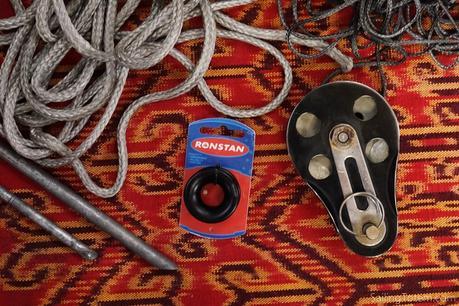
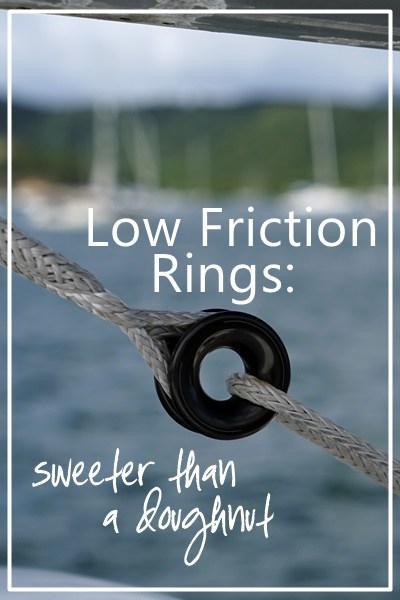
Boom vang improvement
When we bought Totem in 2007, she had a 4:1 tackle vang. No hydraulics, no springs, and also, no good. Thus began a series of efforts to improve the situation.
Totem’s vang upgrade history:
- Evaluated new vang hardware. Choked on cost. Evaluated contents of rigging locker instead.
- Refastened boom vang tang, with new larger fasteners (old ones were pulling out).
- Converted 4:1 vang to cascading 8:1 vang with a block we had and $10 of Dyneema line.
- Boom vang tang pulling away from boom AGAIN. Just say NO to more holes in Swiss cheese boom! Removed tang and replaced with strop around the boom, made from $10 of Dyneema line.
- Mast vang tang broke. Replaced with strop going around the mast, made from $10 of Dyneema line.
- 8:1 was good. 16:1 is better! Added another cascade with a block we had and $10 of Dyneema line.
$40 worth of ¼” Dyneema line and the vang was powered up! Ten years later, our vang is a refined simpleton of rigging goodness.
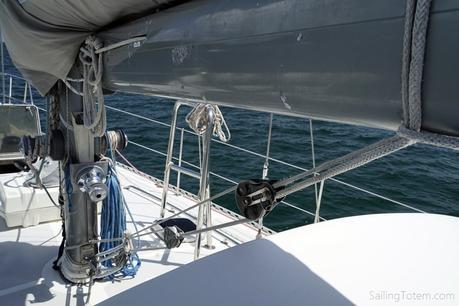
Why is the vang important?
It adds performance when reaching, by controlling mainsail twist (shape of the upper leech). It helps mainsail longevity by reducing chafe against rigging caused by the boom’s rise and fall when running. Also when running, the vang keep the boom from lifting and possibly inducing an unintended gybe. What happens if the boom lifts, is the upper leech collapse towards the luff, and can “back” – gybe! We run with a boom preventer, but the vang cuts the risk further.
To hang a thrifty vang left me wondering if the dang vang would go bang! Well: 46,000 nautical miles later, it did, sort of.
During those years and miles, our cockpit shrank. We blame the children. They just keep growing! Shifting the fiberglass hard top dodger forward about one foot succeeded in opening up the human space…while taking away from the vang space. And this made the vang go BANG! When the vang was eased, the upper block drooped and smacked the dodger front.
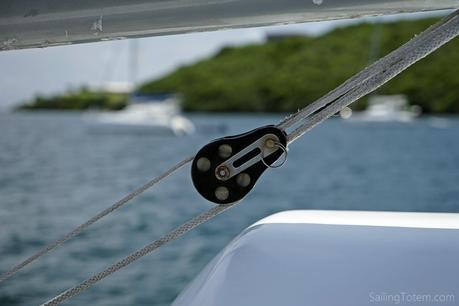
Enter the low friction ring. Modest and elegant. Simple and thought provoking. What the heck does it do? It’s a type of block, but with no moving parts. And a block without moving parts means, FRICTION! Huh? To address this minor inconvenience, marketing geniuses confronted the problem by naming a frictiony block – a Low Friction Ring.
Replacing the heavy block with a lightweight low friction ring was the elegant solution to fixing Totem’s vang…no more bang. Let’s not talk about the Swiss cheese boom feature, but you can see why we opted for a strop some time ago.
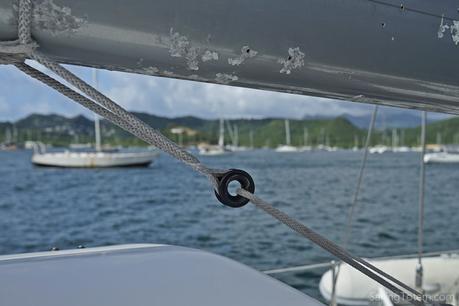
This view brought to you by Mt Hartman Bay, Grenada
What’s the deal with Low Friction Rings?
Why choose a block with more friction and a sneaky name? Several reasons.
- No moving parts! Yes, more friction, but no shattered sheave, chipped cheek, or busted ball-bearings.
- Really strong! Alloy construction and geometric shape result in far higher working loads per block size.
- Lightweight and tough! No maintenance required, just inspect now and then for rough edges or chafe.
- Low cost! As rigging and blocks go, it’s cheap. The one we used in the vang tweak is under $20.
Sounds fantastic, but… isn’t friction not so fantastic on a boat? Well, yes, and no; despite having some friction, low friction rings are a great choice in two types of applications.
Small line deflection
A line going through a block changes angle. This is called deflection. As deflection increases, so does friction. Moderate and big line deflection is the place for blocks with moving parts. Lesser line deflection has less friction, so may be perfect for low friction rings. Possible applications are: furling lines, parts of a lazy jack, foreguy, afterguy, and don’t forget the inhauler! There is no fixed number on maximum angle of deflection, because the amount of line load and type of line affect the amount of friction.
Static and slightly dynamic lines
A mainsheet has a lot of deflection and changing line loads. This is friction soup with a need to make adjustments – so it stays in the realm of blocks with moving parts. Other application can have a little or a lot of line deflection, but not require dynamic adjustment. Set it and forget it. This is the place for low friction rings. And this is where our upper vang block comes in. The line deflects 180 degrees and carries no load or a lot of load, and not much adjustment. My sailboat racing brain scoffs at the thought, but it works for cruising. Tighten the vang, secure, and enjoy the ride.
Other static and slightly dynamic line applications include preventer, leech reef, check stays, running backstays, and barbour hauler. Since this application can have big deflection and line load, the important part is that the adjustment amount must be minimal. There will be FRICTION, so if the line requires much adjustment use a conventional block. When it doesn’t, try a low friction ring for a fraction of the cost.
How a low friction ring is setup is easier to understand in pictures than my clumsy writing: here are some examples of use on Totem.
Mainsail reefing
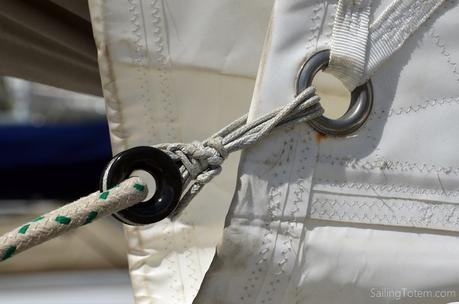
The leech reef line forms an acute angle passing through the leech reef ring in the sail. Consequently, the reefed portion of sails gets scrunched by the unreefed portion of sail and reef line, which can make reefing harder and cause sail chafe. The solution is low friction rings lashed to the leech reef ring. Use 3mm Dyneema line for the lashing, with 6 inches of separation between reef ring and low friction ring. Now the leech reef line passes through the low friction ring giving enough separation so the reefed section of sail isn’t so scrunched. The low friction ring is smoother and has a wider turning radius then the reef ring, making reefing a little easier with less chance for chafe. (More about reefing in this post.)
Furler line lead
Totem’s furler line had been lead after through blocks on the toe rail. See where Siobhan’s hand blithely rests on that Andersen winch? Trace the furler line forward from there, and see the inset zoom for where two low friction rings (orange circles) are used.
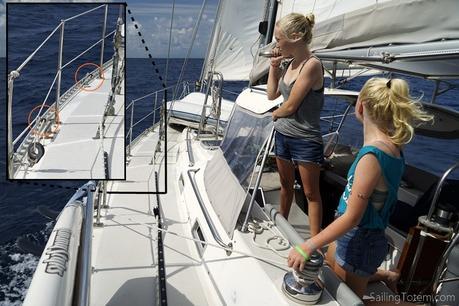
The blocks previously in that spot banged on the deck, they were subject to wear/tear, and were generally just toe stubbers. You can use fancy blocks with a spring, but have you looked at what they cost? Right. That’s most of our monthly food budget! So instead of spendy blocks, Jamie lashed low friction rings as leads: a temporary setup, you know, just to trial the solution. It’s been a YEAR, they work great, and are still in their “temporary” position!
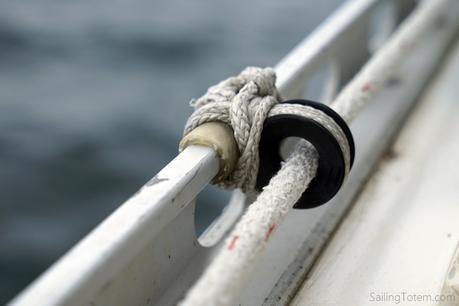
Preventer turning block
Swapping out turning blocks used in our preventer setup is on the shortlist for low friction rings on board. The blocks can flail around, banging the deck, and we know at least one of them shows signs of wear. The blocks in question: one on each side, at the forward point.
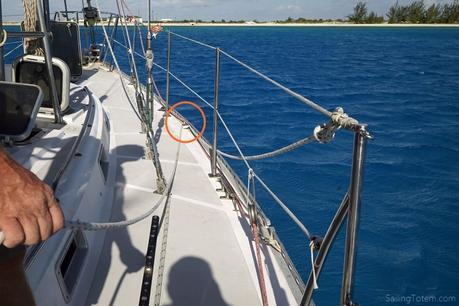
There are a few ways to do this, but swapping the block for a low friction ring just feels like the obvious solution. Here, the fact it won’t bang as much is actually secondary to an even more desirable benefit: the ring is a stronger piece of hardware. More robust? cheaper? that’s easy! And let’s talk about systems on board we don’t want to break… the boom preventer is up there. For a more detailed description of our preventer setup, see Safety on Board: preventer setup on Totem.
Other uses of a low friction ring are climbing their way up the project shortlist. Got any to share? Add in the comments or share on Totem’s Facebook page.
Low friction rings: a sweet treat on any cruising boat.

